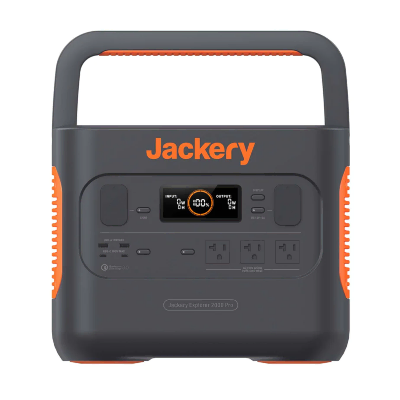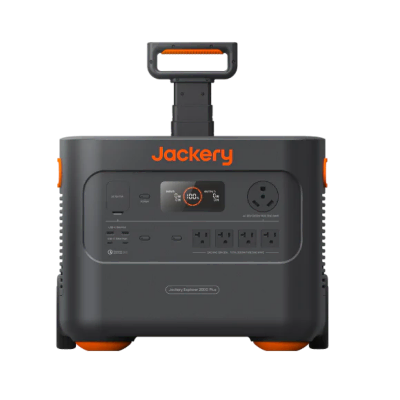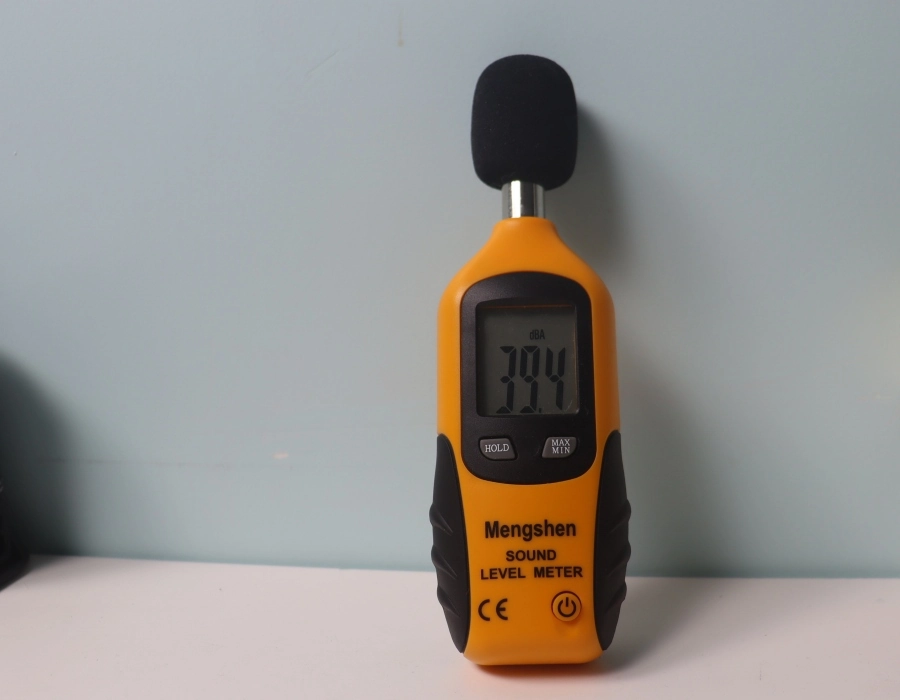In a place with power backup needs:
Today, we have Jackery 2000 Plus and Jackery 2000 Pro models.
From expandable battery capacity to quieter operation, We will cover all the differences and shared aspects.
Beginning with the key differences:
| Jackery 2000 Pro | Jackery 2000 Plus |
|---|---|
 |  |
| Battery Type: Lithium Ion | Battery Type: LiFePO4 |
| Battery Capacity: 2160Wh | Battery Capacity: 2042Wh |
| Expandable Capacity: No | Expandable Capacity: Yes (2kWh – 24kWh), supports parallel connection and battery add-ons. |
| Appliances Compatible: Up To 2200W (4400 Peak) | Appliances Compatible: 3000W (6000W if parallel connected) |
| Solar Charge Duration: 2.5 Hours | Solar Charge Duration: 2 Hours |
| Weight: 43 lbs | Weight: 61.5 lbs (Easy to Carry Wheels) |
| Noise Levels: Standard | Noise Levels: Quieter |
| App Connectivity: No | App Connectivity: Yes |
| Outlets: Eight (2*USB-A, 2*USB-C, 3 AC Outputs, 1 Car Port) | Outlets: Ten (2*USB-A, 2*USB-C, 5 AC Outputs, 1 Car Port) |
| Bottomline: Jackery 2000 Plus stands out. It has a battery expansion option, is easy to move, is quieter, and offers app connectivity. Plus, it can charge more devices at once. | |
| Check Price | Check Price |
Table Of Contents
- Jackery 2000 Plus Benefits & Drawbacks
- Jackery 2000 Pro Benefits & Drawbacks
- Full Comparison Table
- Design & Ease of Use
- The Outlets
- Battery Capacity Expansion
- Parallel Connectivity: Connect Two 2000 Plus Stations
- Battery Types in Jackery 2000 Series Stations
- Safety & Durability
- Quieter model: Is it the Plus or Pro?
- The App Support – 2000 Plus has
- Complete Charging Time (Wall Socket and Solar Energy)
- Device Running Times: Jackery 2000 Pro vs. Jackery 2000 Plus
- FAQs
- Final Words
Jackery 2000 Plus Benefits & Drawbacks
- Fast Solar Charging (In 2 Hours).
- It can work with an approximately 35dB silent level with the provided quiet charging mode.
- Devices like electric grills or stoves could give a battery add-on requirement. The 2000 Plus can expand its capacity to 24kWh.
- The 2000 Plus comes with wheels, so you can carry it like a luggage trolley, but it is quite challenging to lift it up when needed because of its 27 Kg weight.
Jackery 2000 Pro Benefits & Drawbacks
- In this capacity range, 2160Wh, 2000 Pro stands out as lightweight compared to other market models. Comes with a convenient handle for easy carrying.
- The 2000 Pro charges fully in just two hours.
- No battery expansion option for longer camping trips.
- You can’t check or control the power station remotely with the 2000 Pro; it doesn’t have app connectivity.
- The 2000 Pro is slightly loud.
Full Comparison Table
| Device / Specification | 2000 Pro | 2000 Plus |
|---|---|---|
| Dimensions | 12.1*15.1*10.5 Inches | 14.7*18.6*14.1 Inches |
| LED Display | Yes | Yes |
| Foldable Handle | Yes | Yes (with wheels) |
| Weight | 43 lbs | 61.5 lbs |
| No.Of Outlets | 8 | 10 |
| USB-C Ports | 2 | 2 |
| USB-A Ports | 2 | 2 |
| AC Outputs | 3 | 5 |
| Car Port | Yes | Yes |
| Capacity | 2160Wh | 2042Wh |
| Parallel Connectivity | No | Yes |
| Battery Expansion | No | Yes (2kWh to 24kWh) |
| Max AC Output | 2,200W (4,400W Peak) | 3000W-6000W |
| Damage Resistant | Yes | Yes |
| Corrosion Resistant | Yes | Yes |
| Fire Resistant | Yes | Yes |
| Battery Type | Li-Ion | LiFePO4 |
| Quiet Charging Mode | 55dB | 35dB |
| Charging Time | 2 Hours (Wall outlet), 2.5 Hours (Solar) | 2 Hours (Wall outlet), 2 Hours (Solar) |
| Pass-Through Charging | Yes | Yes |
| EPS Mode | Yes | Yes |
| App Option | No | Yes |
Design & Portability
The Jackery 2000 Pro is of dimensions 12.1* 15.1*10.5 inches, whereas the Plus model is 14.7*18.6*14.1 inches.
Both models share the familiar yellow and gray-black color scheme, with the Plus appearing taller.
On the front, besides the outlets, there is an advanced LED display that shows all the operational statuses.
The Jackery 2000 Pro features a foldable handle with a comfortable grip for carrying. However, due to its weight of 43 lbs, some users may find it challenging to move around with.
Now, regarding the weight of the Jackery 2000 Plus, it’s a massive 61.5 lbs (27.89 kgs). But this is not a concern because the Jackery 2000 Plus has wheels and a handle for easy transport. You don’t have to lift it except when loading it into a car or navigating rough terrain where the wheels might not be suitable.
Verdict: The Jackery 2000 Plus with in-built wheels greatly enhances mobility compared to the 2000 Pro.
Speaking of the outlets:
The Outlets
The Jackery 2000 Pro has eight ports, less than the Jackery 2000 Plus, which offers ten outlets.
Both models come with two USB-A ports, two USB-C ports, and one carport. The main distinction arises with the AC outlets.
Jackery 2000 Pro Outlets:
- One Car Port (12V, 10A)
- Three AC Outputs (2200W)
- Two USB-A Outputs (18W Max)
- Two USB-C Outputs (100W Max)
Jackery 2000 Plus Outlets:
- One AC Output (25A Max)
- Four AC Outputs (20A Max)
- Two USB-A Outputs (18W Max)
- Two USB-C Outputs (100W Max)
- One Car Port (12V, 10A)
Verdict: If you require a simultaneous power source for multiple devices, 2000 Plus’s extra outlets help. Otherwise, this difference is less noteworthy.
Battery Capacity Expansion
The Jackery 2000 Pro has a capacity of 2160Wh, while the 2000 Plus has 2042Wh, giving the Pro model a slight edge.
Although the difference isn’t significant, it means the 2000 Pro can power devices for a bit longer than the Plus version.
But it is not the whole. What about capacity expansion? Can we expand the battery capacities of these 2000 series models by adding battery add-ons or by connecting other jackery models?
Yes, that would be more important than base capacity.
With the Jackery 2000 Pro, there’s no option to connect extra battery packs. It is a noteworthy limitation, as even many basic and mid-range models offer expansion possibilities.
The Jackery 2000 Plus comes with an unexpected battery expansion segment that allows you to boost its base 2kWh capacity all the way up to a massive 24kWh. 24kWh? Yes.
The 2000 Plus allows you to connect up to five additional 2000 Plus battery packs. When you do this, it reaches a total capacity of 12kWh. That’s the base 2kWh plus the combined capacity of five battery packs (5 x 2kWh = 10kWh), resulting in 12kWh.
We mentioned 24kWh, but what about the additional 12kWh? You can add this extra 12kWh using the parallel connectivity feature, which we’ll discuss below.
Each 2000 Plus battery pack comes with a front-facing battery level indicator.
Before we dive into parallel connectivity, let’s end our discussion on battery add-on expansion.
However, while this enormous battery expansion sounds exceptional, it may not be the most practical solution. Imagine having to carry around with five battery packs to get more capacity.
In such cases, it might be savvier to consider other high-end power stations with more extensive base capacities for better mobility.
Expanding the capacity from 2kWh to 4kWh or 6kWh provides more extensive power, and many people carry two extra battery packs for this purpose. In such cases, the Plus model proves extremely helpful, whereas the Pro model fails.
Verdict: 2000 Pro does not support battery pack add-on expansion.
Parallel Connectivity: Connect Two 2000 Plus Stations
You have the option to connect two Jackery 2000 Plus units, effectively doubling their capacity from 12kWh to 24kWh. This huge expanded capacity provides you with a more extensive power source – allows the Plus model to handle high-wattage requirement devices, going from 3000W to 6000W.
To get this, connect the two devices using a single parallel drain plug. The plug now will serve as the combined power input source.
Verdict: The 2000 Pro model lacks parallel connectivity, limiting its capacity expansion.
Battery Types in Jackery 2000 Series Stations
Jackery 2000 Plus is fitted with LiFePO4 batteries known for their less degrading, higher safety, and more eco-friendly when compared to conventional lithium-ion batteries in the 2000 Pro model.
In the portable power station world, the LFP and Lithium-ion batteries are top performers. Both take less space to store high capacities.
But, when it comes to long-term reliability and safety, particularly regarding issues like short circuits and voltage fluctuations, the LFP batteries stand out as the more promising type.
Verdict: The Plus version has the top standard Lithium Ferro Phosphate (LiFePO4) battery.
Safety & Durability
Adding to the above super safe and long-lasting LiFePO4 battery pack, the 2000 Plus has a much-advanced facility called charge shield technology that makes it even better from a safety and battery lifespan viewpoint.
The 2000 Pro is with best-in-class Battery Management System (BMS). This system effectively handles the internal charge distribution – eliminates leakage and battery drain, enhancing the regular battery life and overall longevity.
Both the power stations come with fire and damage-resistant exterior body material with rubber holds underneath it preventing direct contact with the floor surface, which might cause scratches. The 2000 series models are damage-resistant, so occasional unanticipated droppings will not break the devices.
Verdict: 2000 Plus ranks slightly higher in safety, but the difference isn’t evident if you use it with proper care and upkeep.
Quieter model: Is it the Plus or Pro?
Portable power stations are necessary backup energy sources that power up huge devices. They often require an internal fan to keep the station components cool. However, when this fan spins, it generates noise. Manufacturers are constantly making efforts to minimize this noise during recharging.
But comparing this noise to traditional fuel-based inverters, portable power stations are significantly quieter. Some models are designed for exceptionally silent operation.
For instance, our Jackery 2000 Plus features a low-noise mode; it charges with less than 35 dB of sound. We have tested the standard noise level in our living room; it comes near 39 dB, which says 2000 Plus quiet charging mode works – quieter you might not even notice when it’s working.

In its default mode, the 2000 Plus produces an average noise level of around 55 dB, similar to the 2000 Pro model.
The quiet charging mode of the 2000 Plus is handy if you have children at home or prefer a peaceful atmosphere during camping trips. It’s worth noting that it takes twice as long to recharge in this quiet mode compared to the default charging setting.
Verdict: In comparison, the Jackery 2000 Pro noise level is not observable in outdoor areas, blending with the usual natural sounds. Yet, in the quietness of your home, it might appear a tad loud. It is where the 2000 Plus wins, creating a peaceful indoor environment.
The App Support – 2000 Plus has
Another downside of the Jackery 2000 Pro model is that it doesn’t offer an app or Bluetooth connection for your mobile device. It is unusual to see power stations at this price point lack an app feature.
But the Jackery 2000 Plus has got you covered.
With the app, you can check the 2000 Plus battery status, receive alerts, customize, monitor real-time progress, and switch to specific modes like low noise mode, as described earlier.
Verdict: The Jackery Explorer 2000 Pro lacks app connectivity, making the 2000 Plus the evident champ.
Complete Charging Time (Wall Socket and Solar Energy)
Jackery 2000 Pro takes 2 hours to charge from 0 to 100% if the input is from an AC wall outlet. Explorer 2000 Plus also takes the same time.
And if it is a car outlet, then 2000 Plus takes 25 hours for a full charge, while the Pro takes 24 hours.
Now, it is time for the key difference. What’s the charge time when connected only to the solar panels?
Here is an upgrade in 2000 Plus, the IBC technology that lets the power station charge faster than other 2kWh capacity models in the market. When connected to six 200W Jackery solar panels, the Jackery 2000 Plus takes 2 hours to get 100% charge.
The time varies depending on the panel count.
| Jackery 200W Solar Panels | Time For Full Charge |
|---|---|
| One Panel | 14 Hours |
| Two Panels | 7 Hours |
| Three Panels | 4.8 Hours |
| Four Panels | 3.8 Hours |
| Six Panels | 2 Hours |
While not as exceptional as the Plus model, the Jackery 2000 Pro is decent – It takes around 2.5 hours for a full recharge through solar panels.
Note: In our research on various top-class solar generators, we’ve found something quite special about the 2000 Plus battery packs, not seen often: you can charge the Plus battery packs using the solar panels.
Verdict: If you regularly recharge the power stations through wall AC outlets – both are similar. But if you camp often and stay for more than a day off-grid? 2000 Plus triumphs with fast solar charge duration.
Device Running Times: Jackery 2000 Pro vs. Jackery 2000 Plus
We put the time into analyzing a few standard-rated household appliances and portable camping devices to estimate their operational durations when powered by Jackery 2000 Pro and Jackery 2000 Plus.
| Device (Power Rating) | 2000 Pro (Hours) | 2000 Plus (Hours) |
|---|---|---|
| Ninja DT251 Electric Oven (1800W) | 1 | 0.9 |
| CUSIMAX Electric Induction Stove (1800W) | 1 | 0.9 |
| EUHOMY Portable Camping Refrigerator (45W) | 38.4 | 36.3 |
| Hamilton Electric Coffee Maker (950W) | 1.8 | 1.7 |
| Whynter ARC-14S Portable Air Conditioner (1300W) | 1.3 | 1.27 |
| BLACK + DECKER Portable Heater (1500W) | 1.2 | 1.1 |
| KNDKO Countertop Portable Ice Maker (255W) | 6.8 | 6.4 |
| BLACK + DECKER Portable Washing Machine (500W) | 3.5 | 3.3 |
| Husqvarna Robotic Lawn Mower (60W) | 28.8 | 27.2 |
We took these device models as samples and used their wattage ratings to calculate estimated running times. It’s important to note that the actual running time can vary significantly depending on device modes, device settings, and other variables.
FAQs
Can I Use Other Brand Solar Panels With Jackery Power Stations?
Yes and no, this is a typical question, but here is a simple explanation. If you already have a different solar panel, you can use it with a Jackery power station.
Please note: The manufacturer won’t cover the warranty if any issue arises. Not just Jackery; all manufacturers are the same in this aspect. If you are looking forward to taking new ones, it is best to stick with the same brand as your power station.
Is it possible to use these power stations while they are in the process of charging?
Indeed, both Jackery models offer pass-through charging, allowing you to power other devices while the station is recharging.
Can these portable power stations charge an electric car?
No, the power station’s capacity is far below the requirement.
Final Words
The Jackery 2000 Plus seems like an upgraded version, considering all the improvement possibilities in the Jackery 2000 Pro.
If there is a massive price difference between these models, we can suggest a model depending on the budget, but the stage is not like that.
The price difference between Plus and Pro is nominal, making the 2000 Plus an attractive choice.
